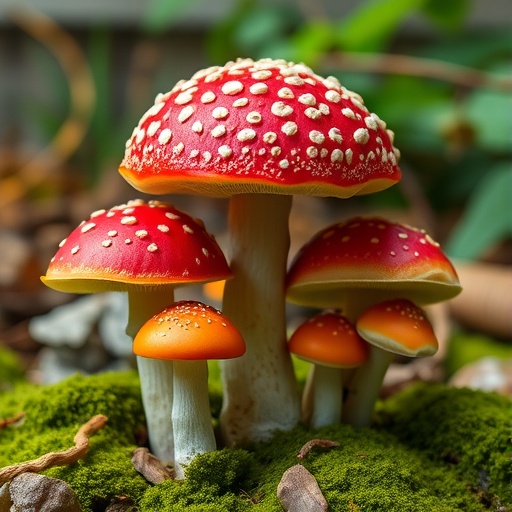In a groundbreaking discovery that redefines our understanding of fungal biochemistry, researchers have unveiled that the psychoactive molecule psilocybin—the active compound famously found in “magic mushrooms”—is biosynthesized via two fundamentally different enzymatic pathways. This study not only challenges previously held assumptions about psilocybin production but also offers profound insights into convergent evolution, a process where distinct organisms independently develop similar traits. The findings illuminate the hidden complexity within fungi and open new doorways for biotechnological applications aimed at pharmaceutical production of psilocybin.
Psilocybin holds a unique position in both natural product chemistry and medicine. Long renowned for its profound psychoactive properties, psilocybin is metabolized by the human body into psilocin, which alters consciousness and perception. Beyond recreational effects, recent clinical trials have highlighted psilocybin’s tremendous therapeutic potential, especially in treating therapy-resistant depression. Despite intense scientific interest, understanding the biosynthetic origins of this molecule within fungal species remained incomplete — until now.
Led by Prof. Dirk Hoffmeister, head of Pharmaceutical Microbiology at Friedrich Schiller University Jena and the Leibniz Institute for Natural Product Research and Infection Biology (Leibniz-HKI), the research team took an evolutionary and biochemical deep dive into the genomes and enzymology of two distinct mushroom genera. Their work culminated in revealing that the known enzymatic machinery operating in the genus Psilocybe—long considered the model for psilocybin biosynthesis—is not the sole biochemical pathway. In fact, fiber cap mushrooms (genus Inocybe) utilize an entirely different suite of enzymes to forge the same molecule.
This dual development of psilocybin production machinery is a remarkable example of convergent evolution. While Psilocybe and Inocybe species differ substantially in their ecology and enzymatic repertoires, both independently evolved pathways culminating in the biosynthesis of psilocybin. In essence, these fungi effectively hold two distinct ‘workshops’ with unique enzymatic tools but produce an identical chemical product. This discovery challenges the dogma that identical natural products necessarily share a common biosynthetic origin within closely related organisms.
Tim Schäfer, the study’s lead author and a doctoral researcher in Hoffmeister’s group, likens the biochemical scenario to two separate factories manufacturing the same finetuned product by different routes: “It was fascinating to observe how fiber cap mushrooms possess a completely unrelated set of enzymes compared to Psilocybe, yet both pathways meticulously catalyze the chemical transformations required to generate psilocybin.” Structural and functional analyses of enzymes, including protein models provided by chemist Bernhard Rupp from Innsbruck, confirmed that the enzymatic steps and active sites in Inocybe fungi are distinct from those classically described in Psilocybe.
While the biochemical divergence is now established, the evolutionary drivers behind this convergent biosynthesis remain largely speculative. Prof. Hoffmeister emphasizes a critical unknown: “We don’t yet understand why these distantly related fungi would evolve to produce the same secondary metabolite, especially given their disparate habitats,” — Psilocybe species often thrive on manure or wood mulch, whereas fiber caps inhabit forest floor litter. The researchers hypothesize ecological benefits tied to defense mechanisms or interspecies interactions may underlie this phenomenon.
One intriguing postulate involves psilocybin’s role as a chemical deterrent against predation. In Psilocybe mushrooms, tissue damage triggers a blue coloration via a cascade of chemical reactions producing psilocybin breakdown products, presumably signaling toxicity or unpalatability to predators. It is plausible that psilocybin acts as a neuroactive defensive molecule, discouraging insects or other organisms from feeding on the fungi, but concrete evidence supporting this function in fiber cap mushrooms is pending further ecological investigations.
The implications of this research extend far beyond academic curiosity. Discovering a novel enzymatic toolkit for psilocybin biosynthesis offers exciting opportunities for synthetic biology and industrial-scale production. Traditional chemical synthesis of psilocybin is complex, costly, and environmentally taxing. Harnessing fungal enzymes for biotechnological manufacturing promises a more sustainable and scalable path to produce this medically valuable compound. Hoffmeister’s team collaborates closely with the Leibniz-HKI Bio Pilot Plant, aiming to develop fermentation processes that could yield pharmaceutical-grade psilocybin efficiently.
Beyond the immediate practical applications, the study enriches understanding of fungal chemical ecology and evolutionary biology. It underscores fungi as chemical innovators within ecosystems, evolving diverse strategies to interact and compete. These findings seamlessly align with broader research endeavors under the Collaborative Research Center ChemBioSys and the Cluster of Excellence ‘Balance of the Microverse,’ both based at Friedrich Schiller University Jena. These initiatives focus on how molecular compounds shape microbiomes and the dynamic interactions between microorganisms and their environment.
In terms of methodology, the team employed comprehensive genomic sequencing combined with advanced bioinformatics to identify gene clusters responsible for psilocybin synthesis. Subsequent functional characterization and enzyme assays validated the distinct biosynthetic routes. This multi-disciplinary approach integrating genomics, enzymology, chemistry, and ecology exemplifies modern natural product research’s holistic perspective, capable of unraveling complex biosynthetic puzzles.
The research not only paves the way for improved production methods but also raises profound questions about the ecological role of psilocybin. Deciphering why evolution repeated itself to create two unique biochemical paths to the same molecule may uncover fundamental principles governing fungal survival strategies, chemical communication, and niche adaptation. Such knowledge could revolutionize how scientists harness fungi to produce bioactive molecules and comprehend microbial ecosystems’ chemical language.
In conclusion, this remarkable discovery expands the frontiers of natural product chemistry and fungal biology by revealing that psilocybin production is not the province of a single enzymatic lineage but arose independently in separate fungal clades. This dual evolutionary origin of psilocybin exemplifies nature’s biochemical ingenuity and provides fertile ground for biotechnological innovation, therapeutic development, and ecological research. The study encapsulates a vital step toward decoding the mysteries of psychedelic mushrooms and harnessing their molecular treasures responsibly.
Subject of Research: Biosynthetic pathways and convergent evolution of psilocybin production in fungi.
Article Title: Dissimilar Reactions and Enzymes for Psilocybin Biosynthesis in Inocybe and Psilocybe Mushrooms.
News Publication Date: 21-Sep-2025.
Web References:
DOI: 10.1002/anie.202512017
Bio Pilot Plant – Leibniz-HKI
ChemBioSys CRC
Balance of the Microverse Cluster
Image Credits: Tim Schäfer, Leibniz-HKI.
Keywords: Psilocybin, magic mushrooms, Inocybe, Psilocybe, convergent evolution, biosynthesis, fungal enzymes, natural product chemistry, pharmaceutical biotechnology, enzyme pathways, fungal genomics, microbial ecology.
Tags: clinical trials on psilocybinconvergent evolution in fungiDirk Hoffmeister research teamfungal biochemistry breakthroughsfungal genomics and enzymologymagic mushrooms researchnatural product chemistry advancementspharmaceutical applications of psilocybinpsilocin metabolism in humanspsilocybin biosynthesis pathwayspsychoactive compounds in medicinetherapeutic potential of psilocybin






